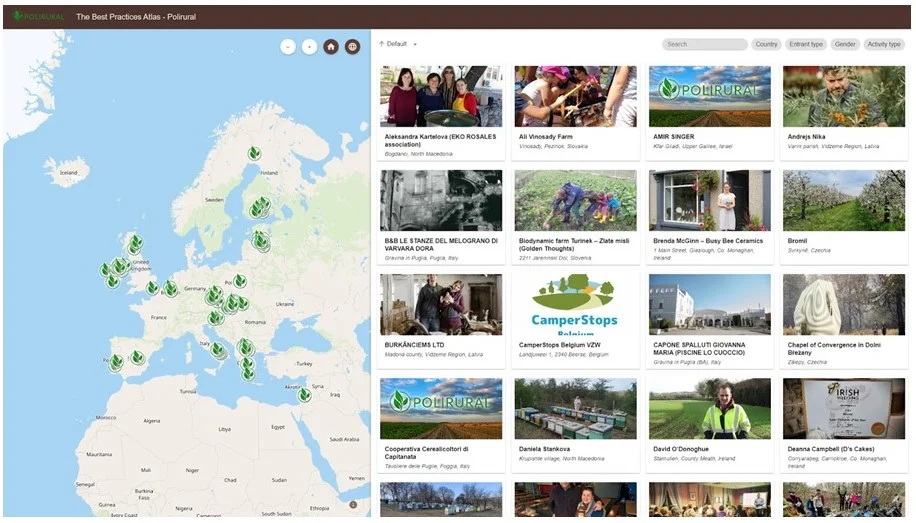Atlas of Best Practices

State-of-the-art
The Atlas of Best Practices is an innovative web-based tool designed to facilitate the sharing of knowledge and experiences among stakeholders involved in various sectors. This platform aims to present exemplary practices that are either fully or partially transferable to other regions or serve as inspiration for partners as well as for stakeholders and all involved entities . By leveraging the technological foundation laid by the Enabling project and enhanced through the Polirural project, the Atlas has evolved into a comprehensive and interactive resource for stakeholders worldwide.
The initial concept of the Atlas was developed within the framework of the Enabling project, which aimed to promote the sharing of information and best practices in biowaste processing. The Enabling project provided a platform for stakeholders to access and share innovative practices, fostering a collaborative environment for the development and dissemination of biowaste processing techniques. The Atlas served as a central repository for these practices, offering detailed descriptions and facilitating the transfer of knowledge across different regions. Building on the foundation established by the Enabling project, the PoliRural project further developed the Atlas by incorporating additional data from pilot regions and individual case studies. The Atlas was enhanced to visualize these examples on a map, providing an intuitive and interactive means for stakeholders to access and explore relevant information. The visualization component included detailed descriptions and markers linked to the map, allowing users to easily navigate and understand the context of each best practice.
Features and Functionalities
The Atlas of Best Practices, now being advanced under the PoliruralPlus project, boasts several key features designed to enhance the user experience and facilitate the dissemination of knowledge:
- Interactive Map Visualization The core feature of the Atlas is its interactive map, which displays various best practices and pilot examples from different regions. Each practice is represented by a marker, which, when clicked, reveals detailed information about the example. This visualization enables users to quickly identify practices relevant to their region or area of interest.
- Detailed Descriptions and Case Studies Each marker on the map links to a comprehensive description of the best practice, including background information, implementation details, outcomes, and lessons learned. This in-depth information helps users understand the practical applications and potential benefits of adopting similar practices in their own contexts.
- Search and Filtering Capabilities The Atlas includes robust search and filtering options, allowing users to narrow down practices based on specific criteria such as region, sector, or type of practice. This functionality ensures that users can efficiently find the information most relevant to their needs.
- User-Generated Content and Collaboration The platform encourages collaboration by allowing stakeholders to submit their own best practices and case studies. This user-generated content is reviewed and curated to ensure quality and relevance, fostering a dynamic and ever-growing repository of knowledge.
- Integration with Related Projects The Atlas is integrated with other related projects and platforms, providing a seamless experience for users who are involved in multiple initiatives. This integration helps create a cohesive network of resources and information, enhancing the overall value of the Atlas.
Objectives of PoliruralPlus
Under the new PoliruralPlus project, the Atlas of Best Practices aims to further expand its scope and impact by:
- Expanding Geographic and Sectoral Coverage The project will work to include best practices from a broader range of regions and sectors, ensuring that the Atlas remains a comprehensive resource for diverse stakeholders.
- Enhancing User Experience Continued improvements to the platform’s user interface and functionality will make it even easier for users to access and share information. This includes optimizing the map visualization, improving search capabilities, and streamlining the submission process for new practices.
- Promoting Knowledge Transfer and Innovation By identifying, synthesizing, and sharing individual examples of best practices, the Atlas aims to inspire new paths and innovative solutions among stakeholders. The platform will serve as a catalyst for collaboration and the dissemination of cutting-edge practices.
- Supporting Policy Development The information and insights provided by the Atlas will support policymakers in developing informed and effective strategies for regional development. The detailed case studies and examples will offer valuable evidence and inspiration for policy initiatives.
- Collaborative Environment with Web Administration The PoliruralPlus project will introduce a sophisticated web administration interface that enables different users, particularly local managers, to collaboratively contribute to the same project within the Atlas. This collaborative environment will support real-time input and updates, allowing for more dynamic and comprehensive data collection and sharing. Local managers will have the ability to input data, update case studies, and manage content, ensuring that the Atlas remains current and relevant.. By enabling multiple stakeholders to contribute and manage content, the Atlas will become a more dynamic and interactive tool for knowledge sharing.